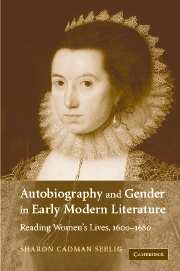Book contents
- Frontmatter
- Contents
- Preface
- Introduction: mapping the territory
- 1 Margaret Hoby: the stewardship of time
- 2 The construction of a life: the diaries of Anne Clifford
- 3 Pygmalion's image: the lives of Lucy Hutchinson
- 4 Ann Fanshawe: private historian
- 5 Romance and respectability: the autobiography of Anne Halkett
- 6 Margaret Cavendish: shy person to Blazing Empress
- Conclusion: “The Life of Me”
- Notes
- Bibliography
- Index
3 - Pygmalion's image: the lives of Lucy Hutchinson
Published online by Cambridge University Press: 22 September 2009
- Frontmatter
- Contents
- Preface
- Introduction: mapping the territory
- 1 Margaret Hoby: the stewardship of time
- 2 The construction of a life: the diaries of Anne Clifford
- 3 Pygmalion's image: the lives of Lucy Hutchinson
- 4 Ann Fanshawe: private historian
- 5 Romance and respectability: the autobiography of Anne Halkett
- 6 Margaret Cavendish: shy person to Blazing Empress
- Conclusion: “The Life of Me”
- Notes
- Bibliography
- Index
Summary
In moving from the diaries and annual records of Margaret Hoby and Anne Clifford to the autobiographies of Lucy Hutchinson, Ann Fanshawe, Anne Halkett, and Margaret Cavendish, we turn again to generic questions. A diary may constitute the final form intended by the writer – as in the diary of Margaret Hoby, which is a fairly immediate and unrevised recording of events – or it may serve as basis for a more coherent narrative form, like the summaries of Anne Clifford's later years. But the life records to which we turn next – those of Hutchinson, Halkett, Fanshawe, and Cavendish – raise much more substantial questions about narrative form and principles. Whereas diaries by their very nature are often concerned with discrete events, a memoir or autobiography forges connections between the disparate occurrences of daily life to construct a narrative line. Although we found in the diaries of Hoby and Clifford considerable purposefulness – in the case of Hoby the accounting for time, in the case of Clifford the justification of herself and her position – an autobiography is much more likely than a diary to articulate the writer's intentions. And whereas a diary or journal might be written to oneself, an autobiography, even if not intended for print publication, presupposes an audience beyond the self. In autobiography we would expect to find a more fully developed and coherent narrative, a more explicitly directed account, a stronger sense of self and of audience.
- Type
- Chapter
- Information
- Autobiography and Gender in Early Modern LiteratureReading Women's Lives, 1600–1680, pp. 73 - 89Publisher: Cambridge University PressPrint publication year: 2006

